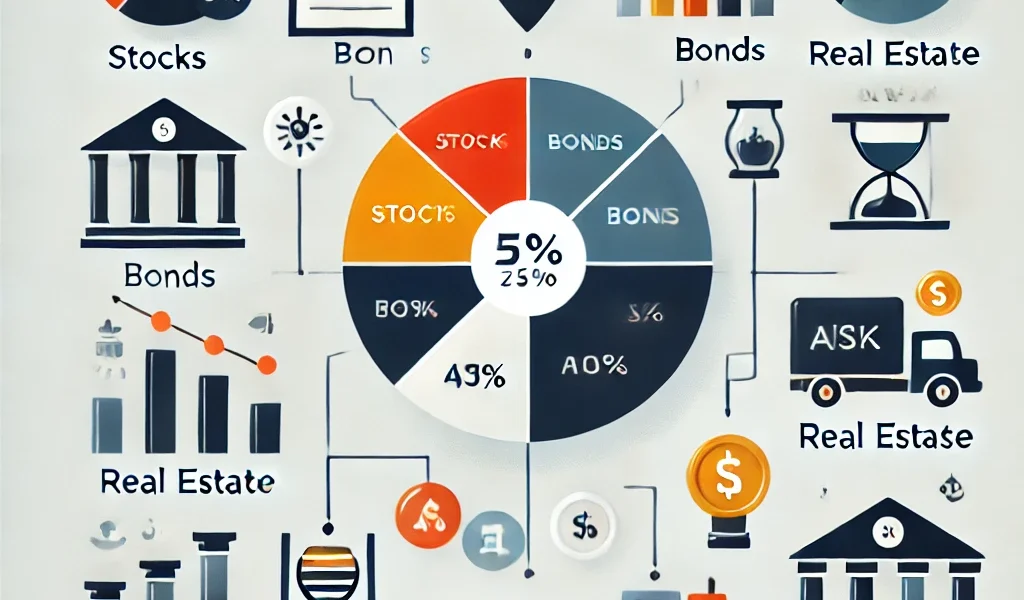The Importance of Diversification in Your Retirement Portfolio: Which One Offers the Best Returns?
Introduction
When planning for retirement, one of the most crucial investment strategies is diversification. A well-diversified retirement portfolio can mitigate risks, improve returns, and provide long-term financial stability. However, many investors either overlook diversification or fail to implement it effectively.
In this guide, we’ll explore:
✔ What diversification is and why it matters
✔ The different asset classes to include in a retirement portfolio
✔ How to balance risk and reward for optimal returns
✔ Strategies to build a diversified retirement portfolio
Let’s dive in!
What is Diversification?
Diversification is the practice of spreading investments across multiple assets to reduce risk. Instead of putting all your money into a single stock, asset class, or sector, diversification ensures that losses in one area can be balanced by gains in another.
Example: If your portfolio is 100% invested in tech stocks, a downturn in the tech sector could significantly impact your retirement savings. However, if you spread your investments across stocks, bonds, real estate, and commodities, a decline in one asset class may be offset by gains in another.
📌 Why Diversification is Essential for Retirement Planning
✔ Reduces Risk: Minimizes the impact of market volatility
✔ Improves Returns: Balanced asset allocation can lead to better long-term gains
✔ Protects Against Inflation: Helps maintain purchasing power
✔ Ensures Stability: Provides consistent returns over time
Key Components of a Diversified Retirement Portfolio
1. Stocks (Equities) – Growth Potential
💡 Why? Stocks offer the highest potential for long-term growth, making them an essential part of any retirement portfolio.
✅ Suggested Stock Diversification
✔ Large-Cap Stocks – Stable companies with strong earnings (e.g., Apple, Microsoft)
✔ Small/Mid-Cap Stocks – Growth companies with higher risk but higher return potential
✔ International Stocks – Exposure to global markets
✔ Dividend Stocks – Provide passive income along with capital appreciation
🔹 Recommended Allocation: 50%-70% (depending on risk tolerance and retirement timeline)
2. Bonds – Stability & Fixed Income
💡 Why? Bonds are less volatile than stocks and provide a steady income stream.
✅ Types of Bonds to Consider
✔ Government Bonds – Safe, low-risk investments (e.g., U.S. Treasury Bonds)
✔ Corporate Bonds – Offer higher yields but carry more risk
✔ Municipal Bonds – Tax-efficient option for long-term investors
🔹 Recommended Allocation: 20%-40% (increasing as retirement approaches)
3. Real Estate – Passive Income & Inflation Hedge
💡 Why? Real estate investments can generate rental income and serve as a hedge against inflation.
✅ Ways to Invest in Real Estate
✔ Rental Properties – Direct investment for consistent income
✔ Real Estate Investment Trusts (REITs) – A more liquid option that offers exposure to real estate without managing properties
🔹 Recommended Allocation: 10%-20%
4. Commodities – Protection Against Inflation
💡 Why? Commodities like gold, silver, and oil protect against economic downturns and inflation.
✅ Types of Commodities to Consider
✔ Gold & Silver – Safe-haven assets that hold value in crises
✔ Energy (Oil & Gas) – Useful in inflationary periods
✔ Agricultural Products – Diversifies risk in volatile markets
🔹 Recommended Allocation: 5%-10%
5. Alternative Investments – Additional Diversification
💡 Why? Non-traditional assets can further reduce risk and enhance returns.
✅ Examples of Alternative Investments
✔ Cryptocurrency – High-risk, high-reward asset class
✔ Private Equity – Long-term investments in startups or private firms
✔ Hedge Funds – Managed portfolios designed for risk-adjusted returns
🔹 Recommended Allocation: 5%-10% (for investors with higher risk tolerance)
Finding the Right Balance: Risk vs. Return
When structuring a diversified retirement portfolio, the ideal asset allocation depends on your risk tolerance and time horizon.
🔹 Age-Based Diversification Strategy
| Age | Stocks | Bonds | Real Estate | Commodities | Alternative Investments |
|---|---|---|---|---|---|
| 20s-30s | 70% | 15% | 10% | 3% | 2% |
| 40s-50s | 60% | 25% | 10% | 3% | 2% |
| 60s+ | 40% | 40% | 10% | 5% | 5% |
📌 Tip: As you approach retirement, shift towards more stable assets like bonds and dividend stocks to reduce risk.
Best Strategies for Portfolio Diversification
✅ 1. Use Low-Cost Index Funds & ETFs
Exchange-Traded Funds (ETFs) and Index Funds allow you to invest in multiple asset classes at low costs.
✅ 2. Rebalance Your Portfolio Annually
Market conditions change over time, so rebalancing ensures your portfolio stays aligned with your goals.
✅ 3. Don’t Rely on a Single Investment Vehicle
Use a mix of 401(k), IRAs, Roth IRAs, and taxable investment accounts to maximize tax efficiency.
✅ 4. Consider Dollar-Cost Averaging (DCA)
Investing fixed amounts regularly reduces the impact of market volatility.
✅ 5. Seek Professional Guidance
A financial advisor can help tailor an investment strategy based on your risk tolerance and retirement timeline.
Common Mistakes to Avoid in Diversification
🚨 Over-Diversification – Spreading investments too thin reduces potential returns.
🚨 Ignoring International Markets – Global diversification reduces U.S. market risks.
🚨 Not Adjusting Allocation Over Time – Shift to safer assets as retirement nears.
🚨 Investing in Similar Assets – Holding multiple tech stocks isn’t true diversification.
Conclusion: Which Portfolio Offers the Best Returns?
There is no single “best” retirement portfolio—the right mix depends on your financial goals, risk appetite, and time horizon. However, a properly diversified portfolio ensures:
✔ Consistent long-term growth
✔ Reduced market risk
✔ Financial stability in retirement
By including stocks, bonds, real estate, commodities, and alternative assets, you can maximize returns while protecting your retirement savings from market fluctuations.
Start diversifying today for a secure and prosperous retirement! 🚀💰
🔹 Need help optimizing your retirement portfolio? Consult a financial expert to create a personalized strategy!




